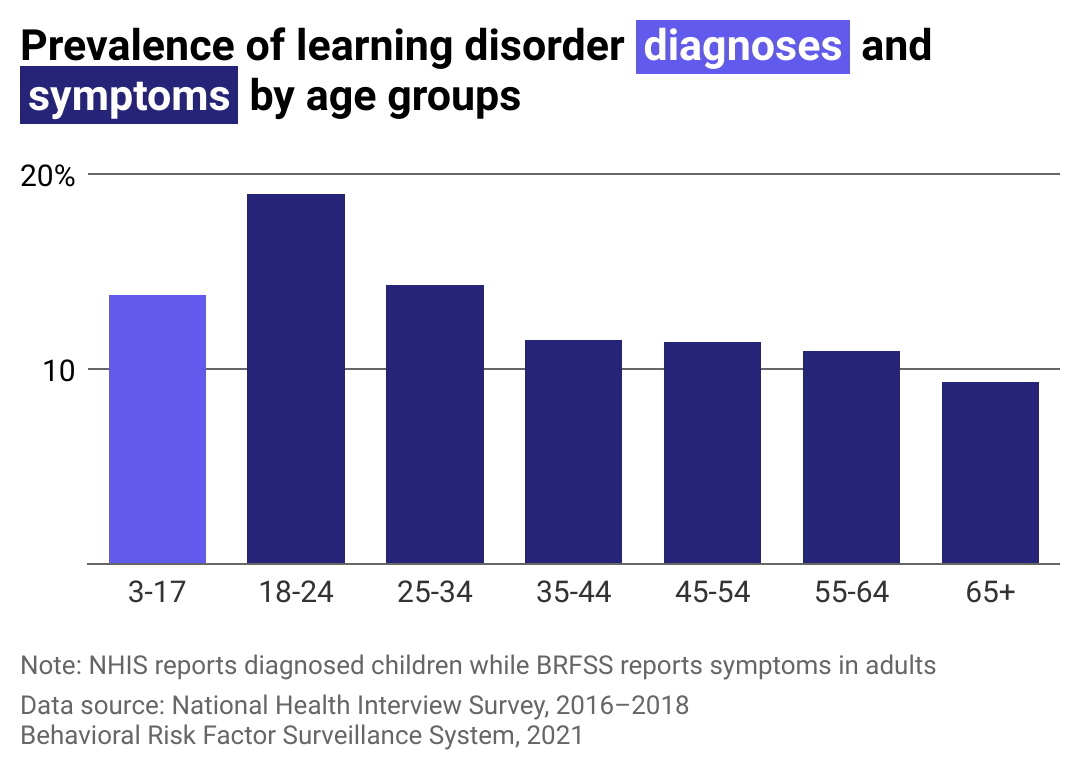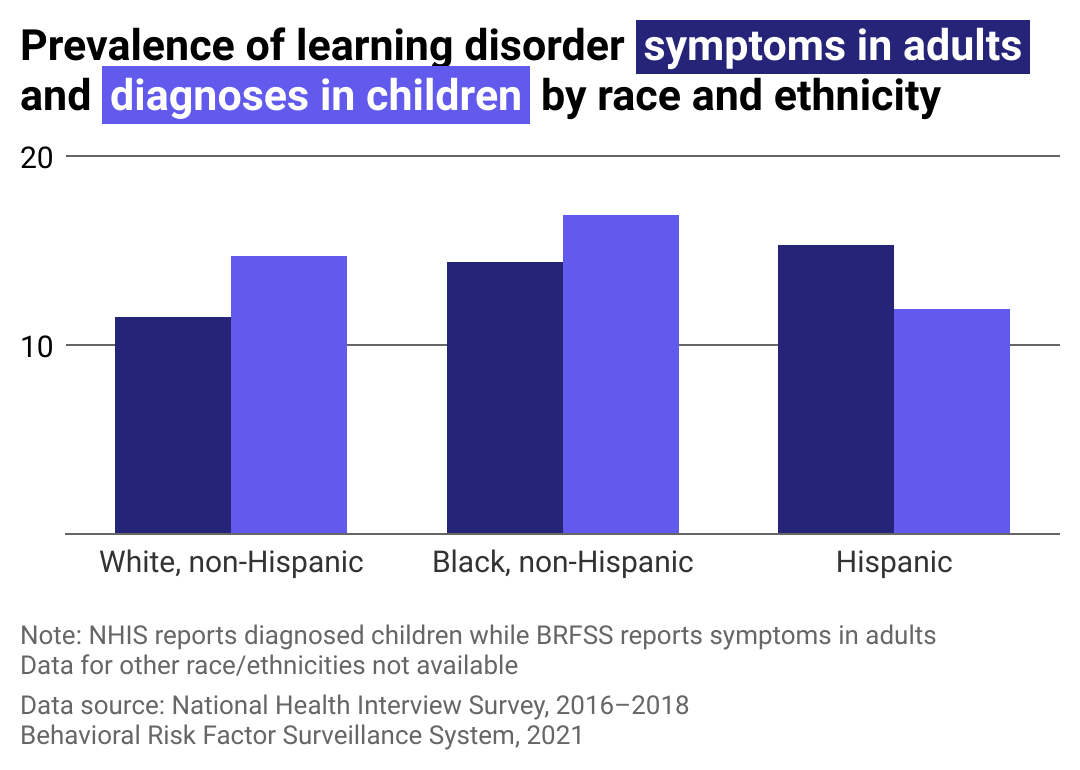Comparing the prevalence of learning disabilities, from kids to adults

Canva
Comparing the prevalence of learning disabilities, from kids to adults
A young child studies stacks of colored blocks.
When an individual’s brain receives and processes information in an unconventional way, or in a way that makes learning new information or skills difficult, the person may have a learning or attention disability. These types of neurodivergence may interfere with the development of basic skills, such as reading, writing, counting, or speaking; they can also impact more complex cognitive tasks, including time management, memory, maintaining focus and attention, and abstract reasoning.
For many, learning disabilities affect more than just their school or workplace performance—they can impact self-esteem, social interactions, and relationships in both children and adults. However, early detection and treatment can greatly improve the quality of life of people facing these challenges. Only clinical experts can accurately diagnose how a learning disability affects each patient and recommend a personalized treatment plan.
The Learning Disabilities Association of America (LDA) cautions that learning disabilities “should not be confused with learning problems.” The latter can result from visual, hearing, or motor impairments, intellectual handicaps, emotional distress, or external disadvantages, such as poverty or malnutrition.
People with learning disabilities usually have an average or above average intelligence, and can have exceptional problem-solving skills or creativity. It is usually when someone notices that a child’s intellect does not match their performance in school that the possibility of having a learning disability is considered. A mismatch between potential and achievements is common evidence of the condition in adults who weren’t diagnosed during their youth.
Marker Learning gathered statistics from a report on the National Health Interview Survey on children with learning and attention disability diagnoses, the Behavioral Risk Factor Surveillance System for indicators of learning disabilities in adults, and other medical reports to examine the differences between learning disabilities in adults and children.
![]()

Canva
Assessments for learning disabilities are more readily available for children than adults
A woman works with a young child using books.
Along with parents, teachers are usually the first to spot signs of possible learning disabilities among school-age children. Though teachers cannot diagnose a student, they can suggest that parents request a medical and psychological assessment.
Many schools have educational psychologists on staff or available through the school district. These mental health care professionals are trained to evaluate a child’s behavior, suggest a treatment plan, or direct the family to a specialized doctor or therapist.
Adults, on the other hand, often must recognize their own symptoms and seek out help, often without certainty of what they are looking for. A learning disability assessment for adults—according to the LDAA—includes four steps: screening, evaluation, diagnoses, and recommendations.

Marker Learning
The highest rates of indicators and diagnoses of learning disabilities cluster in younger-age cohorts
Bar chart showing 14% of children are diagnosed with learning disabilities and rates of learning disability indicators in adults is 19% for young adults and declines for older adults.
About 14% of those 3 to 17 years old are diagnosed with ADHD or other attention and learning disorders; however, young adults ages 18-24 are the ones who most often report having “serious difficulty concentrating, remembering, or making decisions,” common indicators of learning disabilities, followed by those from 25 to 34.
The National Institute of Mental Health highlights that, in adults, these indicators can also be signs of other mental health issues or social stressors, such as PTSD, substance abuse, depression, or bipolar disorder.

Canva
Not all learning disabilities are the same
Two young women work together in a classroom setting.
Some learning or attention disabilities, such as ADHD and dyspraxia, require a comprehensive approach, including medication, therapy, and lifestyle changes. Other conditions, such as dyscalculia, dysgraphia, or dyslexia, are treated using “specific educational approaches and techniques” as early as the diagnosis is available. Similar methods are applied for adults, though the process can take longer.
While a specialized medical professional should supervise both children and adults during treatment, adults become their own progress monitors. The Jonas Hill Hospital & Clinic recommends several strategies to help adults manage learning disabilities while still achieving success in their personal and professional lives. One of them is setting attainable, realistic goals that will encourage the patient to conquer everyday challenges first instead of overwhelming loftier goals.

Marker Learning
Symptoms and diagnoses differ by race, ethnicity, and income
Bar chart comparing diagnoses/indicator rates for kids vs. adults; white and Black children are diagnosed at higher rates than white and Black adults, while hispanic children are diagnosed less than hispanic adults.
Of the three racial/ethnic groups included in the NHIS data, Black, non-Hispanic children have the highest prevalence of learning disabilities; in adults, people who are Hispanic have the highest prevalence. It should also be noted that students of color have historically been overrepresented in special education, a trend often attributed to factors including inaccurate teacher perceptions, misunderstandings of cultural and linguistic behaviors, and systemic bias. Other groups were excluded from the data set due to insufficient sample sizes.
The Centers for Disease Control and Prevention points out that poverty plays a major role in learning disability statistics. The frequency of ADHD and other attention and learning disabilities “differ(s) by federal poverty level for children in all racial and ethnic groups.” Children from households living below 100% of the federal poverty index (18.7%) were more often diagnosed with learning disorders than their more affluent peers.
While much still needs to be done to ensure early and correction identification of attention and learning disabilities, the benefits are enormous. Individuals with learning disabilities and their families must understand that they are lifelong challenges that can be treated and managed with adequate support and intervention. According to the LDA, patients can achieve success and go on to live fulfilling, happy lives.
This story originally appeared on Marker Learning and was produced and
distributed in partnership with Stacker Studio.
